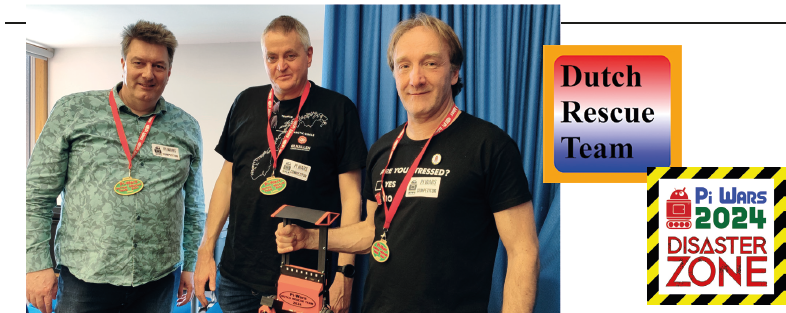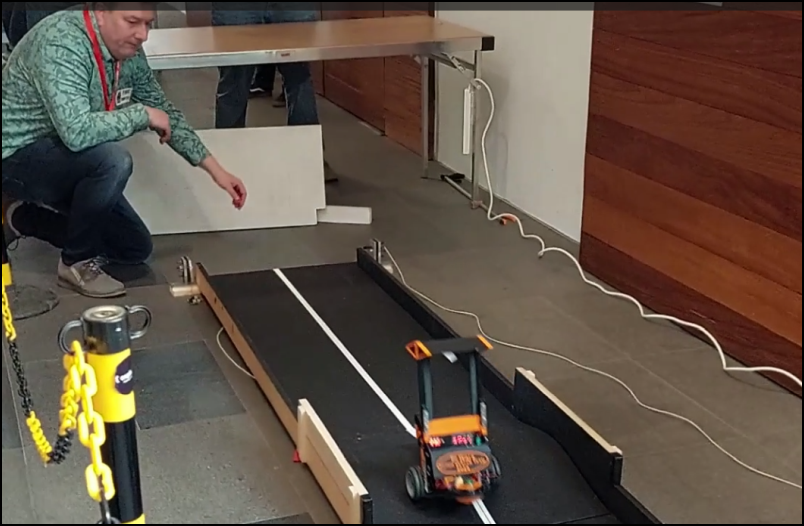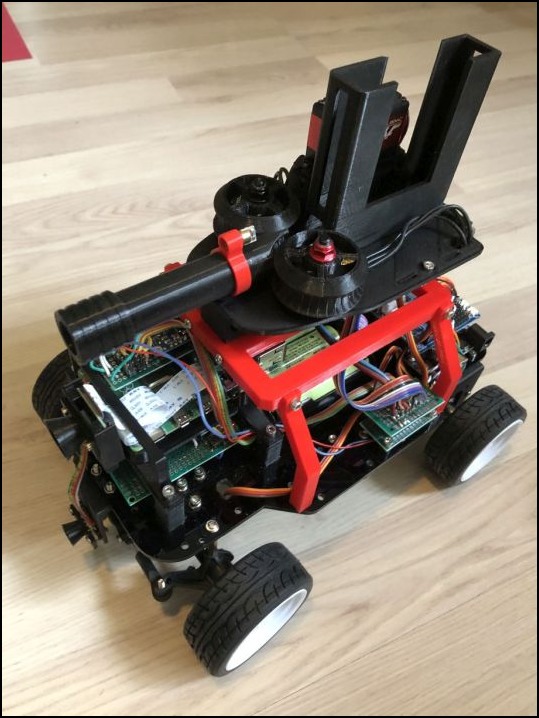
An enthusiastic team from HCC!robotica crossed the Channel to participate in Pi Wars 2024 in Cambridge, England. Their main traveling companion was a self-built robot that took about ten months to complete.
Walter Wijnhoven
 |
| The Dutch Rescue Team with Iwan, Karel and Joep from left to right |
On June 1, 2023, the arrival of Pi Wars 2024 was announced. Pi Wars is an international robotics competition in which teams build Raspberry Pi-controlled robots and compete in various challenges to
earn points. There are teams from schools, clubs, families, groups of hobbyists and solo robot builders. 58 teams from all over the world, including Italy, Spain and the USA, went to the battleground: the Cambridge Computer Laboratory (William Gates Building) of the University of Cambridge. A colorful group of simple robots based on ready-made kits to special high-tech creations.
Initiator Iwan formed a team of six enthusiastic robot hobbyists from HCC!robotica within a week, consisting of Karel, Joep, Aloys, Bert and Koos in addition to Iwan. Four of them traveled to Cambridge as a Dutch Rescue Team. Per team member, experience varies both in time (0 to 20+ years) and in level (beginner to expert) and skills from electronics and coding to 3D printing. Joep: “There are few people who understand all that
have themselves. The saying ‘If you want to go fast, go alone and if you want to go far, go together’ also applies to this journey.

Disaster Zone!
The theme for 2024 was ‘Disaster Zone!’, referring to natural and man-made disasters, with a nod to favorite disaster movies.
There are seven challenges:
-1- Lava Palava – Escape a volcanic eruption
-2- Eco-Disaster – Sort barrels of toxic waste
-3- Escape Route – Navigate a blind maze to the exit
-4- Minesweeper – Find and disarm bombs
-5- The Zombie Apocalypse – Shoot zombies
-6- Pi Noon – The Hindenburg Disaster – Defend your balloons
-7- The Temple of Doom – Go on an adventure and avoid obstacles
Joep: “Actually the first and most important challenge: just come this way with a working robot!” Two teams from HCC!robotica participated: the Dutch Rescue Team in the advanced category and the one-man team RoboPi in the intermediate category.
Raspberry Pi
It is no coincidence that Cambridge is the location for Pi Wars. The Raspberry Pi was developed for educational purposes at the University of Cambridge by the Raspberry Pi Foundation. During Pi Wars you can use multiple boards to perform control and calculations like Arduinos, but the Raspberry Pi board must have overall control. Additional equipment such as a game controller, laptop, mobile phone or tablet may be used to control the robot, but may not be physically attached during the match. The Dutch Rescue Team robot is powered by the Raspberry Pi 4, supplemented by a custom STM32-based microcontroller for the wheel encoders. These count the number of rotations a motor performs, so one real time microcontroller is a must. Good hardware always needs good code; the (micro)controller is coded in C and the applications for the challenges in Python. The main and only sensor is the camera, so everything is done with image processing.
 |
| Start minesweeping |
From ‘doom’ to success
“We started with The Temple of Doom,” says Joep, “a four-meter obstacle course. However, it turned out that we had not spent enough time practicing controlling the robot. We had more success with minesweeping. It was great to see the strategy we had set come to life (see: https://dutch-rescue-team.blogspot.com/2024/04/story-strike-pose.html). This could be done autonomously or by hand – which is faster – but we did it autonomously.”
Zombies in sight
The Zombie Apocalypse was done with the remote control and had a glitch. Joep: “In the preparation room we discovered that we had to turn off the light to see the laser cross, but we decided to take a chance. Unfortunately, on the actual course, the horizontal line of the laser cross was completely invisible. Fortunately we were still able to score a few hits. We noticed this during testing in bright outdoor light, but it was too late to do anything about it.” Despite this imperfection, it became challenge ended with a nice fourth place.
 |
| Part of the Lava Palava course included the robot on the bump that the English call a sleeping policeman.” |
Lava Palava
The team successfully escaped the threatening lava flow of Lava Palava. “The only thing known about the course was that it would contain a bump ‘somewhere’ or something like the English a sleeping policeman name,” Joep explains. “For this purpose we made a special extension to change the center of gravity of the robot, otherwise we would not be able to get over the bump properly. We made a practice bump at home to test. Following a line is not that difficult, but following a line quickly is a challenge, especially if you have a lot of weight at the front like we do. With our extension for the required balance and our camera with OpenCV, we were able to make three smooth runs. Lava Palava earned us first place.” Journalist Les Pounder from Tom’s hardware was quite impressed by this and the team performance was already on Twitter after fifteen minutes: ‘This #piwars robot from Dutch Rescue Team just completed an exceptionally fast line following run!’ Joep: “His interest was already aroused because he thought we had a balancing robot on two wheels, but the third wheel was wrapped to avoid obstacles.”
Disaster as a highlight
 |
| Sorting barrels of ‘toxic waste’ |
Joep: “The Eco Ramp is our personal highlight. A lot of work went into refining this challenge, where a truck had lost a load of barrels where the red barrels leaked and the green ones did not. The barrels had to be picked up and sorted. When it works it looks simple, but it is really quite an art. The robot sees no difference between a barrel that is lying or standing. We received a compliment from the overall winner Team Brian that they were faster in this challenge, but that our control was much greater. We came second autonomously here, just like in the Escape challenge (shared second) which we also completed autonomously.”
 |
| Start of the Escape route |
No balloon, but a blog
After a number of successful challenges, was it time for a party, complete with balloons? Unfortunately, during the elimination race, Pi Noon was unable to puncture the balloons of competing robots, and none of their own balloons remained intact. It didn’t spoil the fun, because there were also additional opportunities to earn more points, including via a blog and via a video. The jury was very positive about this. Joep: “We hope that with our blog, with which we achieved fourth place, we can inspire others and interest them in robotics and perhaps even participate in Pi Wars!” Read the complete blog here: https://dutch-rescue-team.blogspot.com
Unforgettable
Participating in Pi Wars was an unforgettable experience. Bert: “The atmosphere is just great. There are also a lot of young people and even entire families come.” Iwan: “The rules are flexible because you are not supposed to be unable to complete a course after months of working on your robot because of something clumsy. The goal is to get people excited.” Finally, Joep: “We had a lot of fun, including testing together, finding solutions to problems together and regularly holding a mirror up to each other. Not only have most of us acquired OpenCV skills. Individually, various skills were newly learned or improved, such as making molds and casting silicone rubber ‘terrain wheels’ and gaining a much better understanding of installing and using servos.” Ultimately, the Dutch Rescue Team took fourth place in the advanced category. A great achievement for a great group of robot builders!
The one-man team of RoboPi
 |
| A cannon on the RoboPi |
In addition to the Dutch Rescue Team, a one-man team from HCC!robotica also participated in Pi Wars. With varying degrees of success. Rob calls his participation in Pi Wars with his robot RoboPi, with technical support from Kees, ‘not a success story’. Still, despite bad luck, he managed to participate in three challenges.
The problem
Rob was full of expectations with his robot and laptop at the starting blocks, but was only able to participate in three assignments. What went wrong? “My robot worked fine, but my laptop no longer charged via the English socket; you saw the battery drain while the charger was plugged in,” says Rob regretfully. “I was able to participate in the first three games, but then the laptop was empty and I couldn’t start anything else. I found the problem later: a program on the laptop called ‘U-power’ that manages your battery.”
 |
|
| The RoboPi |
RoboPi
Rob looks back on the event and his RoboPi with pride. “My robot has a connector on the front that you can stick extensions to, and on the top you can put a ‘cannon’ on it if necessary. At the front you can measure the distance thanks to the ‘time of flight center’; There are also distance meters between the four wheels that allow you to follow the walls of the track. There is also a Raspberry Pi 4 and an Arduino Uno at the back that, among other things, controls the motor control. A B&O 055 serves as a direction sensor. The robot consists of a number of modules that work together. I haven’t (yet) gotten any further than operating everything with the remote control.”
Join HCC!roboticsHCC!robotica meets every first Saturday of the month in the De Dissel association building in Hooglanderveen (municipality of Amersfoort) from 10:00 AM to 4:00 PM. An enthusiastic group of members enjoy working here on their robots and other hardware. There is a lot of practice, discussion and tinkering. If you want to know more about building robots or get started yourself, come and visit us. You will be welcomed with open arms by the robots and of course the HCC staff. An ideal opportunity to meet other hobbyists, exchange experiences and discuss the challenges that robot builders face. Never a dull moment! More information: https://robotica.hcc.nl |
|
Black or white
“Because a number of well-informed people from HCC!robotics expressed their opinion that a time of flightsensor would not work on a black surface, I was concerned,” says Rob. “I made a small prototype of a black board out of wood, painted with matte black spray paint and tried out the sensor on it. The nice test result was that the tof sensor appeared to work just as well on this black surface as on the white test boards I had used. In short no worries as they say so beautifully in Australia
| |
Read Rob’s complete blog here: Technical and artistic merit movie for team RoboPi: |
|
.”